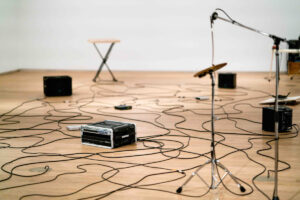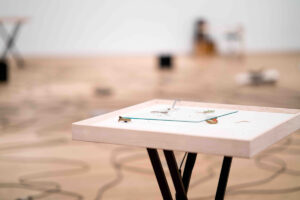A Little Piece of String: Ellen Moffat in conversation with Troy Gronsdahl
This fall, Remai Modern debuted Ellen Moffat’s most recent sound installation, A Little Piece of String. This new configuration of works from her Small Sonorities series is comprised of five “instruments”: an assemblage of everyday objects such as buttons, wire, pine needles and plates combined with common building materials including plywood, steel and glass. Moffat uses software to send digital audio signals of varying frequency and amplitude through material interfaces causing them to vibrate, creating a kinetic composition that trembles, shudders, and howls.
The project launch featured a public performance by Ellen Moffat with musician and sound artist, Jeff Morton. Following the performance Moffat joined curator Troy Gronsdahl for a public conversation which forms the basis of this text.
Troy Gronsdahl: Your recent installation is perhaps more sculptural than musical, but in your performance, the musicality of the piece became much more apparent. To what degree does your background in music inform your work with sound?
Ellen Moffat: I consider the installation and performance as variations on a theme. The collaborative performance with Jeff Morton was based on the idea of counterpoint. We played together with each other, in response to the installation through loose improvisation. I say “loose” because we rehearsed our performance several times; each of us had a set of methods, techniques and actions to generate sound.
For the performance I reduced the chance elements of the composition. The sound/signal was output in a more linear progression. This might have seemed more musical. Also, there’s a difference between the encounter or experience for the audience between performance and installation versions. The performance encourages listening; it’s more like a concert. The installation invites the audience to move through the gallery to investigate the physical materials and kinetic actions, as well as to listen to the sound. Close investigation of the work might reveal relations of actions and sounds.
My work with sound is situated in-between music and sculpture with its language of materials, the body and space. Music is definitely an influence—my background in music includes formal training and informal learning. I studied classical piano into my adolescence as well as violin. I’m self-taught in guitar. I’ve participated in a few choirs as well as noise and improvisation groups. I can read musical notation. I’ve also studied musical theory. These experiences have given me a foundation of musical structure, tone, rhythm and tempo. The fugue, a musical form of two or more voices provides a structure that can expand to polyphony as multiple voices; this extends to my use of multi-channel sound in installation or performance. I’m interested in the musical structures of the theme and variation and the étude, as well as the rhythms and syncopation of jazz. I think of this knowledge and experience as a tool kit or vocabulary for composition.
TG: Did your previous performance-based sound projects inform the development of this installation? What is the relationship between performance and the installation?
EM: It’s difficult to say which came first. The installation is performative. Jeff and I co-performed with the installation for the opening event. It might be easier for me to answer this question by talking about process. Initially, I worked on developing the “instrument”. I experimented with the materials and their limits to determine frequency settings for kinetic actions using a process of trial and error. My goal was to create kinetic-sonic events. Only then was I ready to start the composition for the installation and performance. I wanted a continuously shifting composition, not a fixed or repetitive one. I also wanted to differentiate the installation from the performance as a theme and variation. I approached this question as a logic or predicament for the form and the situation.
TG: The live aspect of the installation seems like an important part of the work. During my experience of the installation I noticed recurring sounds, but as you mentioned, the composition itself is continuously shifting. Can you speak more about how you built this into the piece? Chance also seems to figure into your artistic strategy.
EM: The installation is generating sound as a live mix; it is not pre-recorded. I wanted to use a generative method for sound rather than a fixed composition with a set time. My interest in achieving a non-repetitive, evolving composition led me to chance and uncertainty. I needed to develop a system that would be able to do this task for the duration of the exhibition. As a structure, the instrument is driven by a computer. The software is programmed to combine different sound signals using a process of chance. This opens up multiple possibilities for sound occurrences as sonic intersections or combinations. Jeff Morton customized software for this project to achieve my outcomes. He programmed multiple levels and sublevels of controls as a complex system for signal generation.
TG: Is it fair to say that you are building chance into your system as a way of refusing some sort of closure or completion? Or introducing possibility into an otherwise closed system?
EM: Sure. An open system for sound generation avoids completion or closure of a recognizable and fixed composition. The composition offers a “continuous present” of new layerings and relationships of sound and tone combinations. The listener is in the midst of this ongoing generation of sound rather than in a specific point in the compositional cycle.
TG: I am intrigued by the notion of a “continuous present” as it might apply to your practice. As you’ve mentioned to me previously, you encountered this idea through the writing of Gertrude Stein.
EM: Stein’s continuous present affirms the richness and depth of the present through her consideration of objects. In general, we’re wrapped up in the treadmill of deadlines, schedules, productivity and consumerism. Of course, these are part of our daily lives, and we can’t ignore them. Stein is disruptive; she stalls the linear propulsion of time by returning the reader to the present using simple language and seemingly simple devices such as repetition. She challenges the expectation for the predictable. The work is not simple; rather the simplicity of her language is deceiving. I’ve spent hours with Stein. It’s been a good investment with returns that strengthen my attentiveness to language, meaning, spatial relations and the potential for serious play.
Poems from Gertrude Stein’s Tender Buttons have provided me with inspiration, references and hours of pondering meaning for several projects. To understand her, I need to invert my own “predictable”, to rotate meaning in space, or invert, shuffle or twist my mind and thinking. In this work, I riff with her language and objects as a way to play with meaning, space and words. I love how Stein relocates words. For instance, in the section called “Book”, she moves the object of the book from one location to another through repetition. “Book was there, it was there. Book was there.” I imagine the book in three locations. This repositioning shifts the stability and endorses uncertainty. She presents new ways to consider an object, space and meaning.
I’m using Stein’s text in varying ways: as quotation, translation, punning and wordplay. The subtitle of my work—A Little Piece of String—is a line from Stein. I’m transferring Stein’s language and objects partly through my selection of materials and objects. My use of coffee beans as a sonic material refers directly to Stein’s “piece of coffee”; a measuring spoon riffs on her “practice measurement”.
TG: You share a curiosity in the quotidian, the mundane, the ordinary. Can you speak more about your use of found materials?
EM: I often work with everyday materials, or with materials that are close to hand. I do wonder whether my use of everyday materials is a nod to domesticity or an undoing of domesticity through repurposing materials and through actions. My use of everyday materials has a double function: as a sonic element, and as a point of access to the audience.
My collection of found materials has grown through gifting as well as my own collecting and foraging for domestic and organic matter. I’m currently based in London, Ontario; the city is in an ecological zone called the Carolinian forest, a vegetative belt of trees that stretches from the Carolinas to southern Ontario. This environment is wondrous, intriguing, and provides a new source of materials. Similar to my other collected materials and matter, my interest is their sonic potential.
TG: A Little Piece of String is an exercise in listening but also attentiveness. For me, paying close attention to things goes beyond the initial act of noticing to imply a certain kind of courtesy or care. Does this point to an ethical dimension of your work with sound?
EM: My goal was to construct a sound experience of attentiveness, rather than familiarity. I want to endorse listening as a “what is?” of little sonic subjectivities, of a polyphonic collective, not as a predictable composition that returns to a start. The fluctuation of sound and reverberation might suggest an ecological system, recurrence without repetition or predictability, or social relations as analogies.
Ethics is a large concept, but I’ll try to connect it with my work. My interest is in a collective of diverse parts. The material and sonic elements in the installation propose a collective of difference rather than homogeneity. The social aspect of the work is supported through the medium of sound. Sound impacts the body as felt sensation; it connects us to space/place, to each other and to the senses as relations. As an assemblage of human and nonhuman elements, A Little Piece of String brings diverse rhythms, materials, and sound together in ludic play as a non-commodifiable, social experience. Within our materially saturated world, can this be considered an ethical position? I propose that it does.
Ellen Moffat, Small Sonorities: A Little Piece of String is on view until January 6, 2019. To hear Ellen speak about her project and eavesdrop on her sound installation, visit here
1 In her essay Composition as Explanation, Gertrude Stein elaborates on her approach to writing where she abandoned past, present and future tenses in favour of a continuous present which embraces the idea of “Using everything and beginning again and again and again.”



